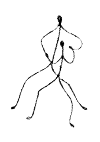 |
ROUND DANCING — CHOREOGRAPHED BALLROOMEDUCATIONAL ARTICLESMAJOR SECTIONS: Figures | Articles | Links | Alph. Index | Search | Home |
|
|
Slow Two Step Is Smooth and Flowingby Harold & Meredith Sears
The name Slow Two Step is a bit of
a
misnomer in that the tempo really isn't particularly slow. It is
slower than most of our regular Two Steps but about the same as Waltz
or Foxtrot, maybe 28–35 measures per minute. But most Slow Two Step
figures do begin with a slow count, a slow side step that can feel
lazily drawn out. For instance, the Slow Two Step Basic is done in a facing position, perhaps butterfly or closed position. We step side with the lead foot, cross behind (woman also) with the trail foot, and recover (SQQ); repeat with the trail foot: side, cross behind, and recover. Don't rush that slow initial step. We step side, reaching, drawing the toes out there, flowing smoothly to the side step. Use all the music that is there in the first slow beat. Sometimes we think of the second and third steps as a "rock-recover," but the rocking step is pretty tight. Don't make it a rock apart, as you might in Swing, and don't give it a bounce as you might in Jive. Slow Two Step isn't jivey — it's smooth. Don't rise to your toes and pop up like a jack-in-the-box. Don't let your body weight fall back. Don't really even take weight fully on the behind step, but turn the foot out, place toe to heel of the supporting foot, and push back in a springy sort of way. You can even reach on the third step, making it more of a flowing thru step, rather than a simple recover step. Either way, we want horizontal elasticity in the arms, not vertical bounce in the legs. The Basic is a figure that stays in place. Traveling Chasses is a figure that progresses. We might be in a cuddly low butterfly facing line of dance. Step forward with the lead foot (woman back) turning 1/8 left-face. Step side toward diagonal line and wall, and then close left to right (woman right to left). In the second measure, step forward and turn 1/4 RF to face diagonal line and wall, step side, and close. Often, we repeat this figure, turning to the diagonal each time, leading with the man's right shoulder and then his left. Notice that we both turn the same direction, first left and then right. The idea is to keep the shoulders parallel and to "slice" forward with the body at an angle to our line of progression (LOD), swaying a bit to the man's left and then to the man's right. Also, keep tone in the arms. The man pushes forward as though pushing a wheelbarrow, curving it a little left and then a little right. The woman's arms must be toned, too, giving him something to push against. If you find it difficult to remember which way to turn your body, just think that these are traveling chasses. To make the side step a traveling step, you must turn toward the foot that took the forward step—first left, and then right. In all of this, keep it smooth. Slow Two Step is a flat, gliding, elastic style of dance.
This article was originally published in Round Notes, CRDA, p.5, Jan/Feb 2010; reprinted Dixie Round Dance Council (DRDC) Newsletter, February 2013.
If you would like to read other articles on dance position, technique, styling, and specific dance rhythms, you may visit the article TOC. Past DRDC Educational Articles archived here. Go beyond this site. Good instructional books and videos, both new and used, are available at low prices from Amazon. Find other references on our Sources and Links pages. |
 |
|
|